

































 What is a wilderness cabin cave?
What is a wilderness cabin cave?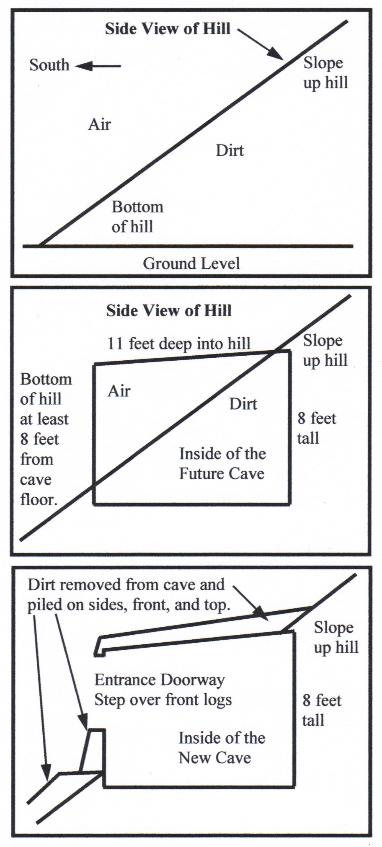 Location: Look for an area where there are a lot of pine trees. Then look for a relatively steep hill or mountain that is at least 20 feet tall and that is not too far from a reliable source of water (stream, creek, river, lake). Steep hills (45 degree or more slope) usually do not contain animal paths or human trails because it takes too much effort to climb straight up a hill this steep. Look for a natural depression in the side of the hill. This will reduce the amount of manual digging you will need to do. If possible the opening to your new cave should be facing south, southeast, or southwest so the inside of the cave will get as much natural sunlight as possible during the day. To avoid possible future flood waters, do not dig your cave at the bottom of a hill. Your cave should be a reasonable distance up the side of the hill based on the terrain. It should be at least 8 feet from the bottom of a short hill, or at least 20 feet from the bottom of a very tall hill or mountain.
Location: Look for an area where there are a lot of pine trees. Then look for a relatively steep hill or mountain that is at least 20 feet tall and that is not too far from a reliable source of water (stream, creek, river, lake). Steep hills (45 degree or more slope) usually do not contain animal paths or human trails because it takes too much effort to climb straight up a hill this steep. Look for a natural depression in the side of the hill. This will reduce the amount of manual digging you will need to do. If possible the opening to your new cave should be facing south, southeast, or southwest so the inside of the cave will get as much natural sunlight as possible during the day. To avoid possible future flood waters, do not dig your cave at the bottom of a hill. Your cave should be a reasonable distance up the side of the hill based on the terrain. It should be at least 8 feet from the bottom of a short hill, or at least 20 feet from the bottom of a very tall hill or mountain.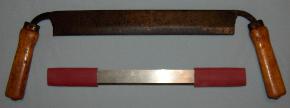 Bark Removal: After you have cut down the pine tree, leave the top and branches on the tree for two weeks because they will pull the moisture out of the trunk of the tree. Then cut off the tree top and the limbs. You can usually cut two or three pine logs from one pine tree. Some of the logs will be ten-feet long and some twelve-feet long. Remove the bark from the pine logs using a tree bark removal draw tool (picture top right with wood handles) or a hide scraping tool (picture bottom right with red rubber handles). To remove the bark pull the tool towards you while applying downward pressure on the tool against the tree. The tool will slip under the bark and strip the bark off the tree. Gradually work from one end of the log to the other. Then rotate the log 1/4 turn and repeat until you have all the bark off the log. You can now move the 10 and 12-foot logs to your cabin cave location. If possible, let the logs dry in the sun for two more weeks after removing the bark.
Bark Removal: After you have cut down the pine tree, leave the top and branches on the tree for two weeks because they will pull the moisture out of the trunk of the tree. Then cut off the tree top and the limbs. You can usually cut two or three pine logs from one pine tree. Some of the logs will be ten-feet long and some twelve-feet long. Remove the bark from the pine logs using a tree bark removal draw tool (picture top right with wood handles) or a hide scraping tool (picture bottom right with red rubber handles). To remove the bark pull the tool towards you while applying downward pressure on the tool against the tree. The tool will slip under the bark and strip the bark off the tree. Gradually work from one end of the log to the other. Then rotate the log 1/4 turn and repeat until you have all the bark off the log. You can now move the 10 and 12-foot logs to your cabin cave location. If possible, let the logs dry in the sun for two more weeks after removing the bark.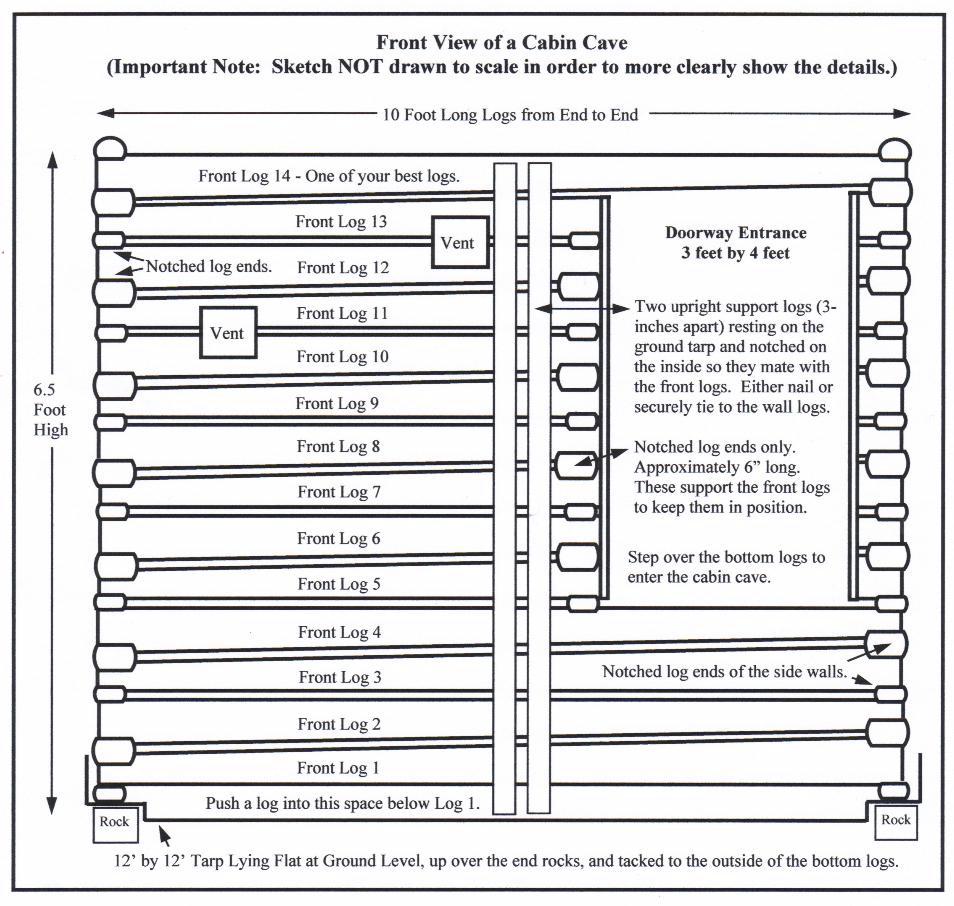
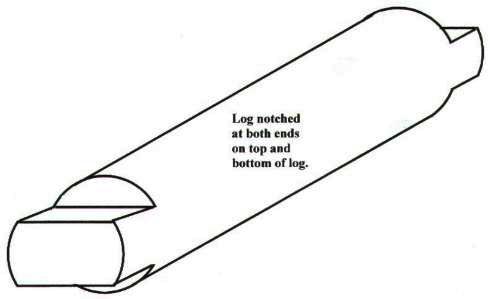 Cut a notch in the underside of each log to match the size of the log below it at the corner. Do not cut a notch more than one-fourth through the thickness at the end of the log. See the notch illustration on the right. You can cut an end notch using a saw by sawing through the log a short distance, and then sawing through the log again at 90 degrees to your first saw cut. You will need to notch the bottom and the top of each log so it will fit level with the logs below and above it at each corner.
Cut a notch in the underside of each log to match the size of the log below it at the corner. Do not cut a notch more than one-fourth through the thickness at the end of the log. See the notch illustration on the right. You can cut an end notch using a saw by sawing through the log a short distance, and then sawing through the log again at 90 degrees to your first saw cut. You will need to notch the bottom and the top of each log so it will fit level with the logs below and above it at each corner. Small Windows or Air Vents: Install two or three small glass windows with wire screens in the front wall. (Note: If you don't have any windows then install simple air vents.) The windows will let sunlight into your cabin cave and they will let you to see what the weather looks like outside. If you see a deer walk by outside and you have a hunting rifle then you could shoot the deer from inside your cabin through the small window. See the first illustration above and the last illustration below for more details about the placement and installation of these windows. For $20 Home Depot sells a 6.25-inch square "Cat Flap" door (picture on right). It has an unbreakable weather resistant clear plastic door that is lockable. The door is in two parts. The swinging transparent door could be mounted on the inside cabin wall. You could then install a wire screen on the other half of the door opening before you mount it on the exterior front wall. During the hot summer months you could prop the inside door open and the wire screen would let fresh air into your cabin but it would keep the insects out. During the winter you could easily replace the exterior wire screen with a square piece of thick glass to provide additional protection from freezing winter weather. The exterior glass would let sunlight into your cabin cave but it would help to form an air pocket inside the wall of your cabin to help keep the freezing air outside. Some fresh air would still enter your cabin in the winter through the large doorway entrance. (Note: After you have finished the rest of your cabin cave, then build an exterior log tunnel using thin logs for each window. However, each window tunnel should gradually get wider as it extends out from the cabin. This will allow more sunlight to enter the cabin and it will provide a downward slope for rain water to flow away from the cabin window. Face one window tunnel directly southwest, one south, and one southeast. This will help to direct sunlight into your cabin cave for the greater part of the day.)
Small Windows or Air Vents: Install two or three small glass windows with wire screens in the front wall. (Note: If you don't have any windows then install simple air vents.) The windows will let sunlight into your cabin cave and they will let you to see what the weather looks like outside. If you see a deer walk by outside and you have a hunting rifle then you could shoot the deer from inside your cabin through the small window. See the first illustration above and the last illustration below for more details about the placement and installation of these windows. For $20 Home Depot sells a 6.25-inch square "Cat Flap" door (picture on right). It has an unbreakable weather resistant clear plastic door that is lockable. The door is in two parts. The swinging transparent door could be mounted on the inside cabin wall. You could then install a wire screen on the other half of the door opening before you mount it on the exterior front wall. During the hot summer months you could prop the inside door open and the wire screen would let fresh air into your cabin but it would keep the insects out. During the winter you could easily replace the exterior wire screen with a square piece of thick glass to provide additional protection from freezing winter weather. The exterior glass would let sunlight into your cabin cave but it would help to form an air pocket inside the wall of your cabin to help keep the freezing air outside. Some fresh air would still enter your cabin in the winter through the large doorway entrance. (Note: After you have finished the rest of your cabin cave, then build an exterior log tunnel using thin logs for each window. However, each window tunnel should gradually get wider as it extends out from the cabin. This will allow more sunlight to enter the cabin and it will provide a downward slope for rain water to flow away from the cabin window. Face one window tunnel directly southwest, one south, and one southeast. This will help to direct sunlight into your cabin cave for the greater part of the day.)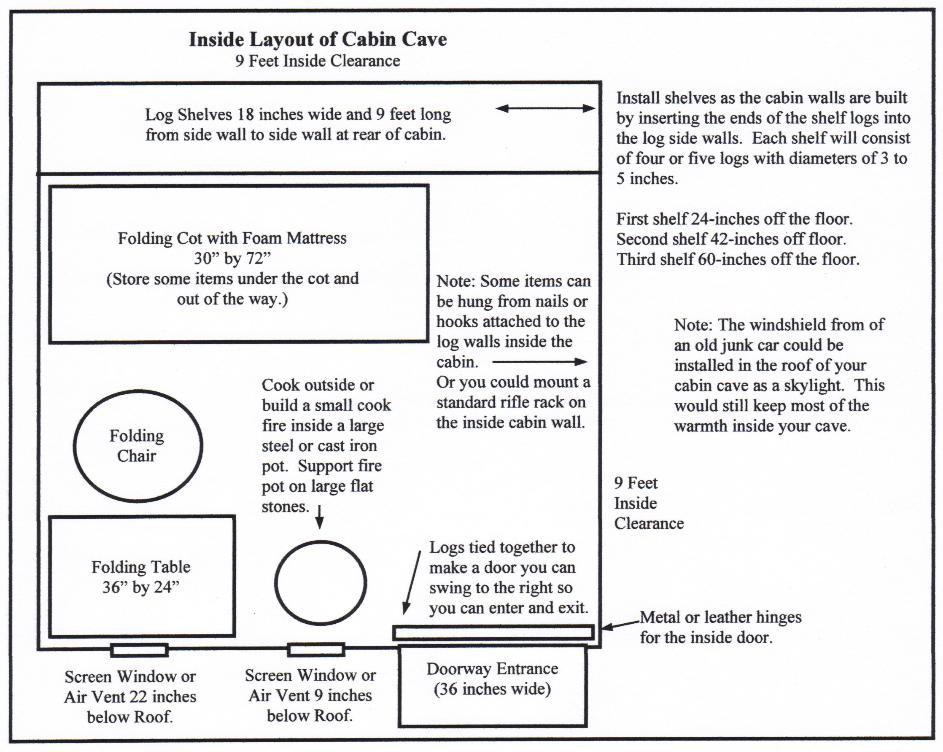
| Quantity | Material Description |
| 2 | 12-foot by 12-foot heavy duty tarps for the floor |
| 2 | 26-foot by 20-foot heavy duty tarps for the roof and 3 walls |
| 2 | 12-foot by 8-foot heavy duty tarps for the front wall |
| 1 | 8-foot by 8-foot camouflage heavy duty tarp. Cut into pieces and wrap in front of the doorway entrance and the window tunnels. |
| 1 | 14 to 18-inch diameter heavy duty steel or cast iron fire pot |
| 3 | 6-inch to 12-inch square screen glass windows that swing in and out |
| 3 | Extra glass panes that will fit the windows |
| 1 | Tube of waterproof caulk sealant for the three windows |
| 4 | Metal Hinges for the interior and exterior doors |
| 100 | 6-inch long nails |
| 100 | 4-inch long nails |
| 50 | Heavy duty wall hooks (shaped like a dish cabinet cup hook - hang pots and pans and other things on the walls) |
| 5 | 200-yard rolls of heavy duty nylon cord, or poly cord, or thin wire |
| 10 | Gallons of Wood Stain or Waterproof Wood Sealer | 1 | Rifle rack (plastic type used inside a truck) |
| Some | Screen wire for the windows |
| 50 | Ten-foot long wall logs (4 to 7-inch diameters) |
| 9 | Twelve-foot long wall logs for the bottom of the right wall (4 to 7-inch diameters) |
| 24 | Twelve-foot long roof logs (3 to 6-inch diameters) |
| 12 | Ten-foot long shelf logs (3 shelves with 4 logs per shelf) (3 to 6-inch diameters) |

